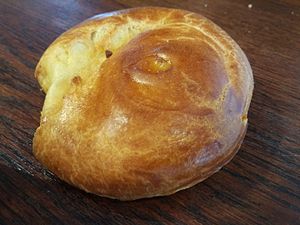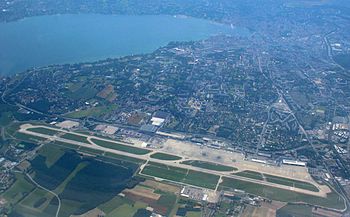 | |
_depuis_Corveissiat.jpg/300px-Rivière_d'Ain_et_hameau_de_Bombois_(Matafelon-Granges)_depuis_Corveissiat.jpg) | |
| Ain department | |
| Capital | Bourg-en-Bresse |
|---|---|
| Residents | 647.634 (2018) |
| surface | 5,762 km² |
| no tourist info on Wikidata: | |
| location | |
 | |
Ain is a department in the French region Auvergne-Rhône-Alpes. It has the ordinal number 01 and borders (clockwise, starting in the north) on the départements law, in the northeast to the Switzerland (Cantons Vaud and Geneva), then the French departments Haute-Savoie and Savoie in the south East, Isère in the south, Rhône in the west and Saône-et-Loire in the north-west.

Landscapes and Administration
&groups=Maske,Track,Aktivitaet,Anderes,Anreise,Ausgehen,Aussicht,Besiedelt,Fehler,Gebiet,Kaufen,Kueche,Sehenswert,Unterkunft,aquamarinblau,cosmos,gold,hellgruen,orange,pflaumenblau,rot,silber,violett)
There are other interesting areas around the Ain landscape:
- Northeast: That Jura Mountains in the department Franche-Comté
- Northwest: the department Saône-et-Loire in the region Burgundy
- West: The department Rhône
- South: the department Isère
- East: The two departments Savoie and Haute-Savoie and the western edge of the Switzerland (Geneva and Vaud)
4 arrondissements with 23 cantons and 409 communes:
- Bourg-en-Bresse - 350 548 Ew.
- Belley - 97 136 Ew.
- Gex - 87 153 Ew.
- Nantua - 84 660 Ew.
places
- 1 Bourg-en-Bresse
 - Prefecture (administrative seat) of the department. The city lies on the western edge of the French Jura. Of the city's 31 historical monuments, the most worth seeing is that Brou Monastery one of the most beautiful late Gothic architectural ensembles in France. Other attractions are the Notre Dame Cathedral with its renaissance facade, that Musee de Brou, the Hôtel-Dieu with a historic pharmacy, the castle of the Dukes of Bresse and the city gate porte des Jacobins from the 15th century. There are also numerous houses from this period in the old town.
- Prefecture (administrative seat) of the department. The city lies on the western edge of the French Jura. Of the city's 31 historical monuments, the most worth seeing is that Brou Monastery one of the most beautiful late Gothic architectural ensembles in France. Other attractions are the Notre Dame Cathedral with its renaissance facade, that Musee de Brou, the Hôtel-Dieu with a historic pharmacy, the castle of the Dukes of Bresse and the city gate porte des Jacobins from the 15th century. There are also numerous houses from this period in the old town.
- 2 Oyonnax
 - is the largest city in the French Jura.
- is the largest city in the French Jura.
- 3 Ambérieu-en-Bugey
 - is located in the Bugey between Geneva and Lyon, at the entrance of the Albarine river into the wide Ain river valley.
- is located in the Bugey between Geneva and Lyon, at the entrance of the Albarine river into the wide Ain river valley.
- 4 Bellegarde-sur-Valserine
 - Without a medieval core, the city has only a few sights to offer. In the Pertes de la Valserine north of the city, the river plunges Valserine into a rocky gorge and then flows under the natural bridge Pont des Oules by.
- Without a medieval core, the city has only a few sights to offer. In the Pertes de la Valserine north of the city, the river plunges Valserine into a rocky gorge and then flows under the natural bridge Pont des Oules by.
- 5 Miribel
 - is located north of the Grand Parc de Miribel-Jonage and is crossed by the Miribel Canal in the south.
- is located north of the Grand Parc de Miribel-Jonage and is crossed by the Miribel Canal in the south.
- 6 Belley
 - with a rich religious past, the cathedral and the former bishop's palace are worth seeing
- with a rich religious past, the cathedral and the former bishop's palace are worth seeing
- 7 Gex
 -
-
- 8 Fernay-Voltaire
 - is located right next to Geneva airport and only 8 km from its city center and thus in the free trade zone of Pays de Gex. The main buildings of the CERN nuclear research center are also in the immediate vicinity. Voltaire lived here from 1759 until his death in 1778.
- is located right next to Geneva airport and only 8 km from its city center and thus in the free trade zone of Pays de Gex. The main buildings of the CERN nuclear research center are also in the immediate vicinity. Voltaire lived here from 1759 until his death in 1778.
- 9 Pérouges
 - is located 30 km northeast of Lyon on a hill in the Dombes near the river Ain. It is one of the most beautiful villages in France (Plus beaux villages de France): a cultural-historical award and classification in France. In the Middle Ages it was Pérouges mostly independent (especially from the Archbishop of Lyon) and came to France in 1601. Due to the emigration in the 19th century, the city gradually fell into disrepair and was not rebuilt until 1911. The historic town ensemble is great and has often been the backdrop for films because of its medieval atmosphere. There are regular cultural events such as jousting games or the music festival Le Printemps de Pérouges.
- is located 30 km northeast of Lyon on a hill in the Dombes near the river Ain. It is one of the most beautiful villages in France (Plus beaux villages de France): a cultural-historical award and classification in France. In the Middle Ages it was Pérouges mostly independent (especially from the Archbishop of Lyon) and came to France in 1601. Due to the emigration in the 19th century, the city gradually fell into disrepair and was not rebuilt until 1911. The historic town ensemble is great and has often been the backdrop for films because of its medieval atmosphere. There are regular cultural events such as jousting games or the music festival Le Printemps de Pérouges.
Other goals
- Côtiere
- Villars-lès-Dombes ornithological park
- Old town of Pérouges
background
language
getting there
By plane
The closest international airport is the ![]() Geneva airport (IATA: GVA)
Geneva airport (IATA: GVA)
- The international
 Lyon Saint-Exupéry Airport
Lyon Saint-Exupéry Airport (IATA: LYS). offers numerous connections from the main cities of France as well as international connections. For example, there are daily flights from Frankfurt am Main, Munich, Stuttgart and Düsseldorf. There is also a shuttle service.
(IATA: LYS). offers numerous connections from the main cities of France as well as international connections. For example, there are daily flights from Frankfurt am Main, Munich, Stuttgart and Düsseldorf. There is also a shuttle service.
By train
There are also good train connections: Bellegarde-sur-Valserine (Connection Lyon-Geneva) and Bourg en Bresse (TGV-Station)
In the street
The connection to the road network (motorway, national road) is excellent.
mobility
The department is well served by trains, motorways and national roads.
Tourist Attractions
- PNR you Haut-Jura - Regional nature park Upper Jura (Upper Jura Regional Natural Park): in the southwest of the Jura on the Swiss border.
- Ars-sur-Formans - Jean-Marie Vianney was pastor here from 1818 to 1859. From 1826 it became a place of pilgrimage because up to 100,000 people annually listened to the sermons of this pastor or confessed to him. The pastor was beatified in 1905 or canonized in 1925 and has been since 1929 Jean-Marie Vianney Patron saint of pastors around the world. The undestroyed body of the saint rests in the basilica attached to the parish church.
- Divonne-les-Bains - Thermal spa in the Pays de Gex at the eastern foot of the Jura, just on the Swiss border near the city Nyon in the canton Vaud. A former moorland east of Divonne-les-Bains was drained and a swimming lake was created (Lac de Divonne - water sports center). To the northwest of the community in the Jura ridge there are typical karst features (cart fields, sinkholes). The place name is of Celtic origin and the waters of the Divonne were already carried over an aqueduct to Nyon in Roman antiquity]]. From the Middle Ages, Divonne changed hands frequently until it finally came to France in 1601 and was re-Catholicized. Since the Congress of Vienna, the community has been part of the free trade zone in the Geneva area. Today is a popular leisure center (also for neighboring Switzerland): casino, thermal baths, racecourse, golf course, cultural center Esplanade du Lac and Forestland.
- Les Dombes - The hilly plateau is to the west of the Saône, to the south of the Rhône, to the east of Ain and to the north by the countryside Bresse limited. Since the 15th century, numerous fish ponds have been created in the depressions with impermeable clay. These provided an important source of income, but also brought malaria, which led to the depopulation of the region. Therefore, the number of ponds was reduced in the 18th century and they have been managed alternately (carp, pike, tench) since then.
- Barrage de Génissiat - The Génissat dam is a gravity dam that dams the Rhône into a narrow lake 20 km in length. When the dam was completed in 1948, Génissiat was the largest hydropower plant in Europe.
- Nantua - is located between Bourg-en-Bresse and Geneva. The small town extends through the Jura chains in Bugey. A lake in the northeast of the city, Lac de Sylans, was created by a landslide in the 16th century.
- Trévoux - The medieval town is located in the far west of the department on the banks of the Saône, 20 km north of Lyon. In the Middle Ages, Trévoux was the gateway of the Holy Roman Empire to France, to which the city came as early as 1523, and at the same time became the capital of the principality Dombes. At the same time, Lyon also became part of France, where a parliament was established, which was moved to Trévoux in the 18th century. -Historical monuments: castle from the 13th / 14th centuries Century; 18th century parliament; old pharmacy, 17th century; Château de Corcelles was expanded into a hunting lodge in the 19th century; Passerelle de Trévoux is a suspension bridge over the Saône]] from 1851;
activities
kitchen
- boudin bressan - Black pudding from the Bresse
- brochet et carpe de la Dombes - Pike and carp from the Dombes
- corniotte de Louhans - a dumpling bag
- crème épaisse - a thickened sauce
- écrevisse - crabs
- galette de Pérouges - Pérouges cake
- huile de colza grillé - Roasted rapeseed oil
- huile de noix - nut oil
- volaille de Bresse (AOC) - Bresse poultry: always a free-range chicken that is fed with maize or buckwheat and slaughtered directly at the breeder.

corniotte de Louhans'
Chicken de Bresse
nightlife
security
The department is calm, there is nothing to fear. Maybe some inconvenience in the suburbs of Bourg and Oyonnax.
climate
trips
- Geneva, was the venue of the UEFA EURO 2008.
- Seyssel (côté Haute-Savoie), Château de Vens and wines (AOC)
literature
- Charles-Henri de Bossieu, Yves Garnier, Philippe Lacrouts (Ed.): Atlas départemental de la France. Larousse, 2004, ISBN 2-03-505448-6 ; 288 pages.








_-_Mairie.JPG/180px-Ferney-Voltaire_(01)_-_Mairie.JPG)
.JPG/328px-Pérouges_(cité_médiévale).JPG)



